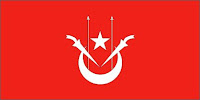Wed, 18 Mar 2009 02:40:18 GMT | PressTV
 The colors of the Kurdish flag reflect off a memorial wall inscribed with the names of each victim of the 1988 Halabja chemical attack. |
Halabja has commemorated the 21st anniversary of the chemical weapons attack that killed between 5,000 and 6,000 people, mostly Kurds and mostly civilians.
On March 16, 1988, former Iraqi dictator Saddam Hussein's military helicopters swooped down into Halabja and the surrounding towns in Iraqi Kurdistan's Sulaymaniyah province and unleashed first bombs, then a combination of deadly gases.
Bodies of civilians were littered on the streets with children in their parents' arms.
Bodies of civilians were littered on the streets with children in their parents' arms.
The Halabja massacre took place at the end of the 1980-1988 Iran-Iraq.
The city still lacks adequate schools, medical care, and housing, residents say.
A new monument, depicting two clasped hands reaching skywards, a symbol for those who were killed, was unveiled on Tuesday and an attached museum was opened .
This year was the first time that the United Nations commemorated the 1988 tragedy. Ambassadors, members of the Iraqi parliament, human rights acivists, and massacre survivors decried the world's silence at the time and urged that steps be taken to ensure that such acts of genocide never occur again.
The city still lacks adequate schools, medical care, and housing, residents say.
A new monument, depicting two clasped hands reaching skywards, a symbol for those who were killed, was unveiled on Tuesday and an attached museum was opened .
This year was the first time that the United Nations commemorated the 1988 tragedy. Ambassadors, members of the Iraqi parliament, human rights acivists, and massacre survivors decried the world's silence at the time and urged that steps be taken to ensure that such acts of genocide never occur again.



















No comments:
Post a Comment